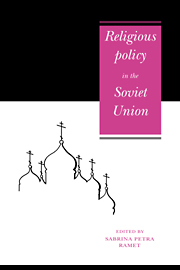Book contents
- Frontmatter
- Contents
- Notes on contributors
- Preface
- Part I Introduction
- Part II Policy apparatus
- 3 The Council for Religious Affairs
- 4 Some reflections about religious policy under Kharchev
- 5 The state, the church, and the oikumene: the Russian Orthodox Church and the World Council of Churches, 1948–1985
- Part III Education, socialisation, and values
- Part IV Cults and sects
- Part V The world of Christianity
- APPENDIX: Religious groups numbering 2,000 or more, in the USSR
- Index
5 - The state, the church, and the oikumene: the Russian Orthodox Church and the World Council of Churches, 1948–1985
Published online by Cambridge University Press: 03 December 2009
- Frontmatter
- Contents
- Notes on contributors
- Preface
- Part I Introduction
- Part II Policy apparatus
- 3 The Council for Religious Affairs
- 4 Some reflections about religious policy under Kharchev
- 5 The state, the church, and the oikumene: the Russian Orthodox Church and the World Council of Churches, 1948–1985
- Part III Education, socialisation, and values
- Part IV Cults and sects
- Part V The world of Christianity
- APPENDIX: Religious groups numbering 2,000 or more, in the USSR
- Index
Summary
One of the most interesting developments in the 1960s was the arrival of the Russian Orthodox Church on the world ecumenical scene. The Third Assembly of the World Council of Churches in New Delhi voted overwhelmingly, on 30 November 1961, to accept this church's application for membership. Until then, the Russian Orthodox Church had remained aloof from the world oikumene.
The entry of the Russian Orthodox Church into the World Council of Churches was only the overture to a suddenly more active participation in international church life. In Debrecen, Hungary, in November 1958, an international meeting of churchmen was held, on the initiative of J. Hromadka, the Czech Reformed theologian; this meeting brought together Christian groups and private individuals from churches in both Eastern Europe and the West, to further the cause of world peace. Soviet delegates were also present.
In 1959, the Conference of European Churches was founded in Nyborg, Denmark, and the Russians were among the founding members. This organisation was intended to serve as a forum and meeting place for European Christians from East and West, to bridge political antagonisms as well as the age-old confessional divisions between the churches of the Reformation and Orthodoxy.
In 1961, the Pan-Orthodox conferences started, with a meeting in Rhodos, to prepare for a Great and Holy Pan-Orthodox Synod. The aim of the conference was to study ways of reconciling and uniting the sundry churches of the Orthodox communion. The conferences have continued ever since, and the Russian Orthodox Church continues to play a predominant role in them.
Contacts with the Orthodox sister churches had already been established since the end of the Second World War.
- Type
- Chapter
- Information
- Religious Policy in the Soviet Union , pp. 105 - 122Publisher: Cambridge University PressPrint publication year: 1992

